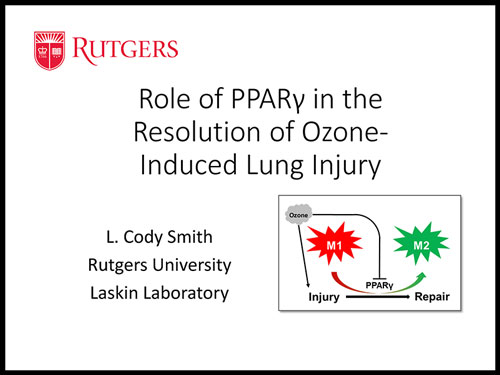REGISTER HERE to join Society of Toxicology for a live webinar workshop chaired by Dr. L. Cody Smith – Single Cell Applications in Mechanistic Toxicology – on April 2, 2020 at 12:00 – 1:30 pm EDT.
Tap images below for video presentations
Chemical Threats
Computational
| Presenter | Lab | Presentation Title |
| H. Zhu | Zhu | Nonanimal Models for Animal Toxicity Evaluations: Applying Data-Driven Profiling and Read-Across |
| K. Zorn | Zhu | Generation of Machine-Learning Models to Anticipate Endocrine Disruption |
| Z. Liu | Gow | INOS-Independent SNO Generation at Low Ph and SNO Prediction Using a Neural Network |
Development
| Presenter | Lab | Presentation Title |
| J. Agudelo | Slitt | Low-Dose PFOS Exposure Alters the Placental Transcriptome in C57BL/6 Mice |
| J. D’Errico | Stapleton | Maternal Health and Placental Outcomes after Pulmonary Nanoplastic Exposure |
| S. Fournier | Stapleton | Exposure to Nanomaterials during Gestation Affects Cardiovascular Health for at Least 12 Months |
| J. Schaefer | Babwah | Regulation of Mouse Uterine Aquaporin Expression in the Preimplantation Period and the Impact of Ovarian Superovulation |
| K. Wiersielis | Roepke | Maternal Exposure to Organophosphate Flame Retardants Alters Locomotor and Anxiety-Like Behavior in Male and Female Adult Offspring |
| R. Zhang | Aleksunes | Interaction of the BCRP Transporter with Cadmium in Human Placentas and Cultured Trophoblasts |
Education
| Presenter | Program | Presentation Title |
| J. D’Errico | THED | Integrating New Technologies into High School Toxicology Education |
| J. Gray | MASOT | Expanding the Reach of Undergraduate Education Programs at Regional Meetings: Model Programs at Four Regional SOT Chapters |
| C. Doherty | SURF | Team Science in a Summer Undergraduate Fellowship: Field Sampling for Metal Contamination in the Raritan River |
Liver and Endocrine
Molecular
| Presenter | Lab | Presentation Title |
| B. Karas | Cooper/Buckley | Evaluation of Metastatic Pathway Inhibition by Novel Ruthenium-Based Metallodrugs Using the Zebrafish Model |
| N. Sparks and L. Walker | Zur Nieden | Tobacco-Induced Transcriptional Dysregulation Associates with Attenuation of Osteogenesis |
| J. Taylor | J. Laskin | Enzyme Kinetic Parameters for Hydrogen Peroxide Generation (Auto-Oxidation) in P450-Related Microsomal Electron Transport Chains |
| X. Wen | Aleksunes | Loss-of-Function Variant in the BCRP/ABCG2 Transporter Increases Cadmium Renal Injury In Vitro |
Neurological
| Presenter | Lab | Presentation Title |
| A. Eid | Richardson | RNA-Seq Evaluation of DDT Exposure in the Hippocampus of APOE Mice |
| Y. Jan | J. Laskin | Protection against Parathion-Induced Neurotoxicity by a Menadione/Vitamin C Combination Drug |
| A. Morris | Hart | Assessing DDT/DDE in Alzheimer’s Disease Pathways in Human Stem Cells-Derived Neurons Carrying APOE Gene Variants |
| C. Nadolny | Richardson | Regulation of Ubiquitin Specific Peptidase 2 by Farnesoid X Receptor in Glioblastoma NCI-60 Cell Lines |
Pulmonary



